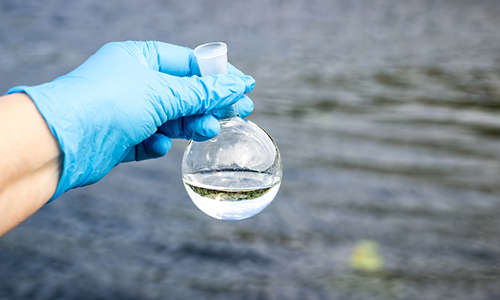|
|
|
|
|
|
| |
|
|
| |
Argonne National Laboratory designs fitter filters for cleaner water. |
|
| |
|
|
|
| |
|
|
| |
|
|
| |
| |
|
|
| |
(iStock.com/Irina Vodneva) |
|
| |
|
|
|
|
| |
|
|
|
| |
|
|
| |
All life on Earth requires water to survive*, and humans need clean, fresh, and plentiful water to thrive. But in many inhabited regions of the world, water is polluted, salty, or scarce. |
|
| |
|
|
|
| |
|
|
| |
As part of an effort to advance a new water cycle, where water is filtered, treated, and reused as often as possible before being sent back to the environment, Argonne National Laboratory and the Institute for Molecular Engineering are working to engineer high-functioning membrane filters. |
|
| |
|
|
|
| |
|
|
| |
Organic or synthetic, membranes serve as gatekeepers--letting select particles in, keeping certain elements out, and capturing would-be intruders to deal with later. For such delicate material, they do tough work, and researchers in Seth Darling's lab are designing new materials to last longer and work more efficiently. |
|
| |
|
|
|
| |
|
|
| |
One type of membrane Darling's team created is a Janus membrane, which is chemically treated so that each side has a different property, such as opposite electric charges. That asymmetry allows for more specialized membranes and reduces their energy requirements. |
|
| |
|
|
|
| |
|
|
| |
|
|
| |
| |
|
|
| |
This bust in the Vatican Museums depicts Janus, the Roman god of passages, transitions, and gateways. This god who looks forward and backward lends his name to the first month of the Gregorian calendar and a two-faced membrane. (Photography by Fubar Obfusco, Public Domain Mark 1.0) |
|
| |
|
|
|
|
| |
|
|
|
| |
|
|
| |
It requires extreme precision to coat only one side of a 160 µm‐thick membrane, so Darling's lab turned to atomic layer deposition (ALD), an industrial technique capable of depositing a thin film of material one atomic layer at a time. |
|
| |
|
|
|
| |
|
|
| |
Ruben Waldman, IME doctoral student and coinventor of several new membranes, discovered ALD as a solution during what was first thought to be an unsuccessful experiment. |
|
| |
|
|
|
| |
|
|
| |
Waldman was investigating the ALD technique to treat both sides of a membrane and noticed that the bottom side wasn't getting fully coated. So he decided to optimize the (now intentional) partial layering to create Janus properties. |
|
| |
|
|
|
|
|
| |
|
|
| |
These new materials and techniques could help open the floodgates for clean, accessible water around the world. |
|
| |
|
|
|
| |
|
|
| |
*Ironically, some types of tardigrade, also called water bears or moss piglets, can dry up and be rehydrated years later like nothing happened, inspiring different materials science research at IME. |
|
| |
|
|
|
|
|
|
|
| |
|
|
| |
|
|
|
| Marine Biological Laboratory scientists identified a gatekeeper molecule that ferries sodium into and protons out of sperm cells, increasing the chances of a successful egg fertilization. |
|
|
|
| |
|
|
|
|
|
| |
|
|
| |
|
|
|
| The Parker Solar Probe, named for UChicago's own Gene Parker, has passed through the sun's corona--hotter than its surface--capturing the closest-ever images of the sun. |
|
|
|
| |
|
|
|
|
|
| |
|
|
| |
|
|
|
| IME scientists use liquid crystals to manipulate the shape of synthetic cell membranes, which could aid in drug delivery. |
|
|
|
| |
|
|
|
|
|
|
|
|
|
|
|
|
|
| |
|
|
| |
|
|
| |
| |
|
|
| |
NASA's Voyager 1 and Voyager 2 probes are now both outside the heliosphere, a protective bubble created by the sun that extends well past Pluto's orbit. Voyager 1 exited the heliosphere in August 2012. Voyager 2 exited at a different location in November 2018. (NASA/JPL-Caltech) |
|
| |
|
|
|
|
| |
|
|
|
| |
|
|
| |
In 1977 NASA project scientist Ed Stone, SM'59, PhD'64, sent two probes on a mission to explore the solar system. Voyager 1 and Voyager 2 finished their tours of the planets back in 1980 and 1989, respectively, and as of last November, they had both crossed into interstellar space. |
|
| |
|
|
|
| |
|
|
| |
The heliopause is the boundary that defines where interstellar space begins. It's the place where solar wind dies out, where particles originating from elsewhere in the Milky Way are no longer deflected by our sun's influence. The plasma of the interstellar medium--the gas and dust that fills the space between stars--is much denser. Voyager 2 still has a functional plasma instrument transmitting data to Earth, so learning it had crossed over was easy. Voyager 1 had to wait for a space tsunami. |
|
| |
|
|
|
| |
|
|
| |
While the heliopause is the edge of the sun's particle influence, many astronomers believe the Voyager probes won't leave the solar system until they pass through the Oort Cloud, a sphere of icy bodies anchored by our sun's gravity, in roughly 30,000 years. |
|
| |
|
|
|
|
|
|
|
|
|
| |
|
|
| |
Photogenic:
South Pole Telescope points newest camera at big bang's light.
|
| |
|
|
|
|
|
|
|
|
|
|
| |
|
|
| |
| |
|
|
| |
Good things come to those who share! Forward µChicago to a friend and be entered to win a prize. Congratulations to last month's contest winner, Jean Lachat.
Sign up to receive µChicago monthly. |
|
| |
|
|
|
|
| |
|
|
|







